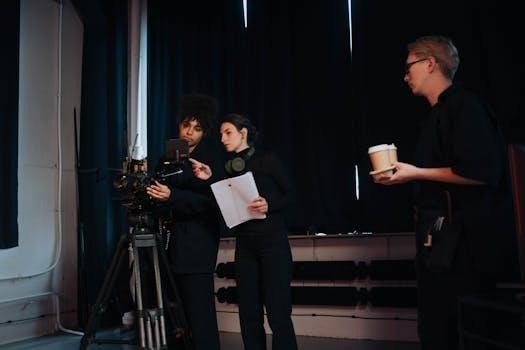Talk to Me Movie Script⁚ A Comprehensive Analysis

Dive into the chilling world of “Talk to Me” with a comprehensive script analysis. This involves dissecting the narrative structure, character arcs, and thematic elements that contribute to the film’s horror and emotional impact. Explore the nuances that make the script a compelling blueprint.
Understanding the Premise of “Talk to Me”
“Talk to Me” centers around a group of teenagers who discover a way to conjure spirits using an embalmed hand coated in ceramic. This artifact allows them to briefly invite ghosts into their bodies, leading to an intoxicating and dangerous thrill. The premise explores the allure and consequences of crossing the boundary between the living and the dead. Initially, it seems like a game, a way to experience something extraordinary and escape the mundane realities of their lives. However, the film quickly escalates as the teens become addicted to the experience, pushing the limits of what they can handle.
The core of the premise lies in the vulnerability of the human body and mind when exposed to supernatural forces. The rules are simple⁚ hold the hand, say “Talk to me,” and allow a spirit to enter. But the most critical rule, and often the hardest to follow, is to sever the connection before it’s too late. The script delves into the psychological impact of possession, questioning the control individuals have over their own bodies and the potential for malevolent entities to exploit their desires and weaknesses. Ultimately, “Talk to Me” is a cautionary tale about the dangers of playing with the supernatural and the devastating consequences that can arise when boundaries are crossed.
The Original Script vs. The Final Cut⁚ Exploring the Differences
Delving into the evolution of “Talk to Me,” it’s fascinating to examine the original script compared to the final cut that audiences experienced in theaters. Reports suggest that the initial script was even more extreme and brutal than the movie we see. This implies that certain scenes were toned down or removed during the filmmaking process, potentially to manage the film’s rating or to refine the overall narrative impact.
Often, changes between the original script and the final film involve pacing adjustments, character development nuances, or alterations to specific plot points. Some scenes might be cut for budgetary reasons or because they don’t quite fit the film’s tone during editing. Additional scenes may be added to clarify plot elements or enhance emotional resonance. Analyzing the script’s structure, character development, and themes provides further insight.
The creative process is dynamic, and filmmakers often make adjustments based on test screenings, feedback from producers, or their own evolving vision. By comparing the original script to the final cut, we gain a deeper understanding of the choices made during production and how they shaped the film’s ultimate form and impact on viewers.
Danny and Michael Philippou⁚ The Filmmaking Duo Behind “Talk to Me”
Danny and Michael Philippou, the twin brothers behind the chilling horror film “Talk to Me,” have quickly become a notable filmmaking duo in the genre. Known initially for their work on YouTube, where they created prank videos, they transitioned into feature films with a distinct vision. Their approach to filmmaking often involves innovative techniques and a willingness to push boundaries.
Danny Philippou has spoken extensively about not using a rigid outline when diving into a script, suggesting a more intuitive and character-driven writing process. This approach may contribute to the film’s raw and unpredictable feel. The brothers’ background in online content creation likely influenced their understanding of audience engagement and how to build suspense.
Their collaboration extends beyond directing; they also co-wrote the script for “Talk to Me” with Bill Hinzman, based on an idea by Daley Pearson. The Philippou brothers’ unique blend of skills and their unconventional approach to screenwriting and direction have established them as a creative force to watch in the horror genre. Their perspective offers a glimpse into the innovative and imaginative world of modern filmmaking.
The Screenwriting Process⁚ From Idea to Script
The journey from the initial concept to the final script of “Talk to Me” involved a collaborative effort between Danny Philippou, Bill Hinzman, and Daley Pearson. Starting with a core idea, they built the narrative, developing characters and plot points. Danny Philippou has mentioned not using an outline, suggesting a more organic, character-led approach.
The screenwriting process likely involved multiple drafts, revisions, and refinements to achieve the desired emotional impact and horror elements. The writers focused on creating a strong opening image, which serves as a foundation for the story. As they wrote, they learned more about their characters and the movie’s overall direction.
The script’s structure, dialogue, and pacing were carefully crafted to build suspense and engage the audience. The screenwriting process also included incorporating specific horror elements and themes that resonate with viewers. The final script provided a roadmap for the filmmakers to bring their vision to life on screen. The script effectively balanced entertainment with deeper themes, ensuring the film’s memorable impact.
Analyzing the Script’s Structure, Character Development, and Themes
The script of “Talk to Me” exhibits a carefully constructed structure, designed to escalate tension and maintain audience engagement. Character development is central, with protagonists facing moral dilemmas. Mia’s journey, in particular, showcases a compelling arc of grief, vulnerability, and ultimately, tragic choices.
Themes of grief, trauma, and the dangers of escapism are woven throughout the narrative. The script explores how these themes impact the characters’ decisions and relationships. The horror elements serve as a backdrop to explore deeper, more complex emotional issues.
The script utilizes pacing and dialogue to build suspense and create a sense of unease. Flashbacks and other narrative devices are employed to reveal character backstory and motivations.
The script’s analysis reveals a strong correlation between structure, character development, and thematic exploration. These elements combined to create a cohesive and impactful narrative. The script’s success lies in its ability to blend horror with emotional depth, making it a memorable and thought-provoking viewing experience.
Mirrors and Foils⁚ Script Analysis Techniques in “Talk to Me”

In analyzing the “Talk to Me” script, the techniques of mirrors and foils offer valuable insights into character relationships and thematic resonance. Mirrors are characters who reflect aspects of the protagonist, highlighting their strengths, weaknesses, or potential paths. Foils, conversely, contrast with the protagonist, emphasizing their unique qualities.
By examining these relationships, we can gain a deeper understanding of Mia’s character arc. Are there characters whose experiences mirror her own grief, offering alternative responses to trauma? Are there characters who act as foils, highlighting the destructive nature of her choices?
The use of mirrors and foils can also illuminate the script’s themes. For example, are there characters who mirror the dangers of escapism, demonstrating its potential consequences? Are there characters who offer contrasting perspectives on grief, suggesting healthier coping mechanisms?
The strategic deployment of mirrors and foils enriches the narrative, adding layers of complexity to the characters and themes. This analysis technique helps to uncover the subtle nuances of the script, revealing its deeper meaning and impact.

The Significance of the “Embalmed Hand” in the Script
The “embalmed hand” in the “Talk to Me” script is more than just a macabre prop; it serves as a potent symbol and a catalyst for the film’s central conflicts. Its presence acts as a tangible link between the living and the dead, blurring the boundaries between reality and the supernatural.
The hand’s significance lies in its ability to grant temporary access to the spirit world. This power becomes both alluring and dangerous, tempting characters with the thrill of otherworldly experiences while exposing them to unforeseen risks.
The hand also represents the characters’ desire for connection, particularly in the face of grief and loss. It offers a fleeting sense of communication with the deceased, but ultimately proves to be a deceptive and destructive substitute for genuine human connection.
The script utilizes the hand to explore themes of grief, trauma, and the dangers of seeking solace in the supernatural. It acts as a physical manifestation of the characters’ vulnerabilities and the consequences of their choices. The hand, in essence, becomes a mirror reflecting their deepest desires and fears.
Exploring the Horror Elements and Their Scripted Execution
“Talk to Me” masterfully employs various horror elements, meticulously scripted to maximize suspense and dread. The script leverages psychological horror, delving into the characters’ emotional vulnerabilities and blurring the line between reality and hallucination. This is achieved through vivid descriptions of the characters’ experiences while possessed, forcing the audience to question what is real.
The script also utilizes body horror effectively, depicting the disturbing physical transformations that occur when spirits inhabit the characters’ bodies. These scenes are carefully crafted to evoke visceral reactions and create a sense of unease.
Furthermore, the script employs jump scares sparingly but strategically, using them to punctuate moments of heightened tension and shock the audience. These scares are not gratuitous but rather serve to amplify the psychological horror already established.
The script’s success lies in its ability to blend these elements seamlessly, creating a cohesive and terrifying experience. The script prioritizes building suspense and dread over relying solely on gore, making the horror feel more impactful and lasting.
Screenlife Storytelling and Mobile Phone Perspective

“Talk to Me” incorporates elements of screenlife storytelling, reflecting the pervasive influence of mobile phones and social media in modern life. While not a purely screenlife film, the script strategically integrates mobile phone perspectives to enhance realism and immediacy. Characters frequently use their phones to record events, communicate, and document their experiences with the embalmed hand.
This approach allows the audience to witness events through the characters’ eyes, creating a sense of intimacy and vulnerability. The use of shaky camera footage and fragmented recordings adds to the film’s raw and unsettling atmosphere.
Furthermore, the script explores how social media can amplify the dangers of the supernatural. The characters’ desire for online validation and the thrill of capturing paranormal experiences leads them to make reckless decisions, ultimately exacerbating the consequences of their actions.
By integrating screenlife elements, the script taps into contemporary anxieties surrounding technology and its impact on human connection. This approach makes the horror feel more relevant and relatable, resonating with audiences who are constantly immersed in the digital world.
Marketing Strategies⁚ Releasing Sequences Online Anonymously
The filmmakers behind “Talk to Me” employed a unique and innovative marketing strategy by releasing sequences from the project anonymously online. This unconventional approach aimed to generate buzz and intrigue among potential viewers before the film’s official release. By uploading short, cryptic clips without any context or attribution, the filmmakers created an air of mystery that piqued the curiosity of online communities.
These anonymous releases served as a form of viral marketing, encouraging viewers to speculate about the film’s plot and themes. The unsettling and visually striking nature of the sequences further amplified their impact, prompting viewers to share them across social media platforms.
This strategy effectively tapped into the power of online word-of-mouth marketing, generating organic interest in the film. By withholding information about the project’s origins, the filmmakers created a sense of anticipation and excitement that ultimately contributed to the film’s success.
The anonymous release of sequences online also allowed the filmmakers to test the waters and gauge audience reactions to the film’s horror elements. This feedback could then be used to refine the marketing campaign and tailor it to the specific interests of the target audience.
Availability of the “Talk to Me” Script⁚ Where to Find It
For aspiring screenwriters, film students, and avid fans of “Talk to Me,” accessing the film’s script can provide invaluable insights into the craft of screenwriting and the creative process behind the movie. However, obtaining a copy of the script may require some diligent searching.
Official sources, such as the film’s production company (A24) or distributors, may occasionally release the script for promotional purposes or as part of educational initiatives. Keep an eye on their websites and social media channels for any announcements regarding script availability.
Online script databases, such as SimplyScripts and Scripts.com, are valuable resources for finding screenplays of various films. While the “Talk to Me” script may not be readily available on these platforms, it’s worth checking periodically as users may upload transcripts or unofficial versions.
Academic libraries and film schools often maintain collections of screenplays for research and educational purposes. Contacting these institutions may provide access to the “Talk to Me” script or other relevant materials.
Fan-made transcripts, created by dedicated viewers who painstakingly transcribe the film’s dialogue, can also be found online. While these transcripts may not be official, they can still offer a valuable resource for studying the film’s structure and dialogue.
Discussion and Analysis of Key Scenes from the Script
Delving into the script of “Talk to Me” reveals the intricate details that make its key scenes so impactful. One such scene involves the initial seance with the embalmed hand, where the thrill of connecting with the other side quickly escalates into terrifying possession. Analyzing the script’s descriptions of the characters’ reactions, the dialogue, and the escalating tension provides insight into how the filmmakers built suspense.
Another pivotal scene is when Mia, grappling with grief and trauma, becomes increasingly consumed by the spirits. The script likely details her emotional state, physical transformations, and the chilling interactions with the entities she encounters. Examining this scene allows us to understand how the writers portrayed the psychological and supernatural horror elements.
The climax, where the consequences of the characters’ actions reach their peak, is another crucial scene for analysis. The script would reveal the visual cues, dialogue, and pacing used to create a sense of dread and impending doom. Consider the script’s choices in portraying the characters’ desperation, the escalating stakes, and the ultimate resolution.
By dissecting these key scenes, we can appreciate the craft of screenwriting and how the script translates into the film’s overall impact.
The Impact of the Script on the Film’s Overall Reception
The script of “Talk to Me” has undeniably played a significant role in the film’s overwhelmingly positive reception. Critics and audiences alike have praised its tight narrative structure, compelling characters, and exploration of profound themes. The script’s success lies in its ability to blend horror elements with genuine emotional depth, creating a story that resonates beyond mere scares.
The carefully crafted character arcs, particularly Mia’s journey through grief and possession, contribute significantly to the film’s emotional impact. The script’s dialogue, pacing, and visual cues work in harmony to create a sense of dread and suspense, keeping viewers on the edge of their seats.
Furthermore, the script’s exploration of themes such as grief, trauma, and the allure of the unknown has resonated with audiences on a deeper level. The film’s ability to tap into universal human experiences, while simultaneously delivering chilling horror, has set it apart from typical genre fare.
Ultimately, the “Talk to Me” script has served as a solid foundation for the film’s success, providing a compelling story, well-developed characters, and thought-provoking themes that have captivated audiences worldwide.

